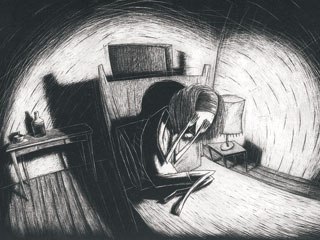Philippe Moins attends the 2006 Annecy Festival, giving us his impressions of the films and an apparent return of British filmmakers.
Is British animation on the way to recovering some of the creative vitality we witnessed in the 80s and 90s?
This is the question that springs to mind when looking at the prizewinners list from the 2006 Annecy Festival, where four British films won a total of six prizes between them, starting with Joanna Quinns Dreams and Desires Family Ties (Special Jury Prize, Audience Prize and Fipresci Prize).
In regards Quinns film, its not so much a revelation than a confirmation of a talent which has consistently matured the gift for caricature and verve of this Welsh-by-adoption filmmaker is as, as ever, consummately expressed, in this stunning re-invention of amateur documentary filmmaking. A fine piece of virtuoso animation, the likes of which is rarely seen today. Run Wrakes Rabbit (Jury Special Mention) is undoubtedly the winner with the most contemporary feel, although the filmmaker actually took his inspiration from a 1950s reading primer picture book.
In awarding these particular films, alongside others just as graphically oriented, the jury no doubt intended to emphasize that drawing is and continues to be the essence of animation. This was abundantly clear in its choice of Tragic Story with Happy Ending by the Portuguese filmmaker Regina Pessoa for the Annecy Cristal. When graphic style is accompanied by a strong (voice-over) text, one begins to wonder have the mechanical revolutions of 3D computer animation started to run out of steam?
However lets not be too hasty in claiming victory. The all too predictable Delivery by Till Nowak (Germany), which won the Jean-Luc Xiberras Prize for First Film, is a good example of that type of 3D animation in which the software application used is more recognizable than any authorial touch.
Fortunately there are antidotes to the boredom often induced by the sameness of so many of the films, one being the hilarious One D, by Canadian filmmaker Michael Grimshaw, an opportune choice made by the Junior Jury, as well as those student films full of caustic humor such as Tony Comleys Abigail (Great Britain), which garnered a special mention in the student film category, and Matthew Walkers Astronauts (Great Britain), which won the prize for Best Student Film.
In a more serious vein, films that were overlooked by the juries include Jonas Odells Never like the First Time (Sweden), the documentary Kein Platz für Gerold by Daniel Nocke (Germany) and the deeply disturbing Levijatan by Simon Bogojevic Narath from Croatia. At a time when political and philosophical metaphors are seemingly somewhat out of fashion, this may be something of a handicap for a number of films from eastern Europe, which draw on such a tradition, such as Marek Skrobeckis Ichtys from Poland, undoubtedly one of the major works in competition. The nightmarish and iconoclastic manner of conveying a persistently frustrated expectation and hope is certainly less likely to appeal to contemporary taste, as if lightheartedness, indeed triviality had become a necessary condition for coronation in a world of little Mickeys.
In terms of feature films, the diversity of the international and European sneak previews (Grégoire Solotareff and Serge Elissaldes U, Giul Kenas Monster House, Michel Ocelots Azur et Asmar, John Lasseters Cars, Marco Villamizar's Piccolo, saxo et compagnie, Hayao Miyazakis Nausicaa, Valley of the Wind, Seiji Ariharas Nagazaki 1945 the Angelus Bells, Mori Masakis Gen dHiroshima) compensated for an unappealing competition selection, which included a number of feature films that had already been released theatrically. In this context, the Grand Prix for Christian Volckmans Renaissance, from France, was quite predictable. It would have been highly unlikely to see a film that has been on general release for more than six months, such as Wallace and Gromit: Curse of the Were-Rabbit get the prize.
For the rest, a number of retrospectives, exhibitions, tributes and special programs confirm the validity of the framework established by Jean Luc Xiberras, which has been perpetuated and expanded upon by festival director Serge Bromberg and his team. Beyond the usual logistical and physical impossibility of being able to see everything, (some of the most original programs were only screened once), it should be stressed that the system works brilliantly, creating an impression that the world of animation is as rich as the world itself. Which isnt entirely mistaken, although it is amusing to see the extent to which the same filmmakers and the same subjects re-occur periodically in any self-respecting festival.
Every international animation festival has a kind of trompe lil effect. It should be acknowledged theres a very good reason for this as each new generation of animators emerges, they really need to become aware of the mediums past. On seeing some of the films in the official selection, which are both empty and full of clichés, one tells oneself one cant have too much of a festival like Annecy (and some others) to encourage the development of a real and well-informed culture through its retrospectives.
Philippe Moins is writer and teacher in Belgium, and also co-director of the Brussels Animation Festival ANIMA.











